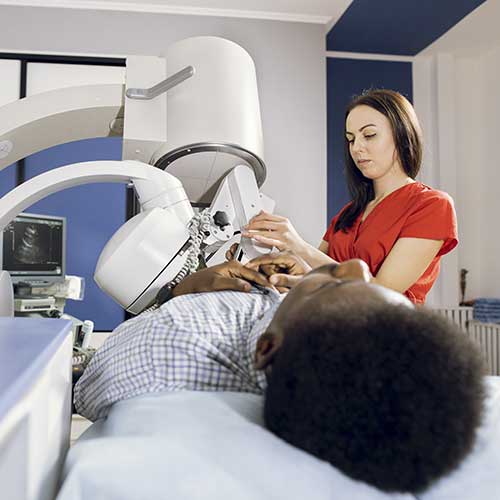Data from INCA (National Cancer Institute) and the Brazilian Society of Urology reveal that testicular cancer is the most common neoplasm in men between 20 and 40 years old and corresponds to 5% of all cancer cases in Brazilian men.
The European Society of Urology and the American Cancer Association reveal that the incidence of testicular tumor has been increasing in recent decades, especially in industrialized countries and it is estimated that currently there are up to 10 new cases/year per 100,000 men and for the year 2019 there will be approximately 71,000 new cases and 9,500 deaths in the world.
The testicles are located in the scrotum, the pouch under the base of the penis.
More than 95% of testicular cancers begin in the germ cells, which are responsible for producing sperm. The most frequent neoplasms of germinal origin are Seminomas and Non-Seminomas.
One of the main characteristics of testicular cancer is the rapid growth of the tumor with a high power of distant dissemination (metastasis), but when diagnosed early, the chances of cure are high.
Risk factors that increase the probability of testicular neoplasia are known and we highlight cryptorchidism (presence of the testicle outside the scrotum), personal or family history of testicular cancer, Klinefelter Syndrome and testicular carcinoma in situ.
Most of the time, the first symptom of testicular cancer is the simple identification of a painless, hardened and fast-growing nodule, which leads the patient to look for a urologist.
The testicular tumor, in the initial stages, can simulate other diseases of the scrotum that cause pain and increase in volume, such as inflammation of the testicle (orchitis) or the epididymis (epididymitis), in addition to hydrocele (fluid in the scrotum), varicose veins (varicocele), cysts, bruises and even hernias.
A rare sign of testicular cancer is breast enlargement (gynecomastia) which may be accompanied by pain (mastalgia). This happens because certain types of germline tumors secrete high levels of a hormone called human chorionic gonadotropin (HCG), which stimulates breast development.
In cases of advanced disease, the patient may experience weight loss, pain in various parts of the body or respiratory discomfort due to tumor involvement in other organs.
Testicular cancer can and should be found at an early stage. Digital self-examination of the testes is ideal, and the best time to perform the test is during or after a shower, when the scrotum is relaxed.
The Urologist makes the diagnosis of this neoplasia from the identification of the signs and symptoms reported by the patient, added to a physical examination that identifies a nodule in the testicle, in addition to the analysis of laboratory tests (alphafetoprotein, human chorionic gonatropin and lactic dehydrogenase) that are not always altered and an ultrasound, the most indicated imaging method for tumor tracking.
Multidisciplinary treatment may be necessary, but surgery is the first step in treatment that can often cure the patient. The surgery occurs through an incision in the inguinal region (verrilla), known as radical orchiectomy (removal of the testicle, epididymis and spermatic cord). The scrotum is not opened, and the side of the bag where the testicle was extracted is empty, allowing the implantation of a testicular prosthesis.

Complementary treatments such as radiotherapy, chemotherapy and complete surgeries may be indicated, after analyzing the type of cancer cell found, the tumor extension and the presence or absence of metastasis, which will be evaluated by computed tomography.
Faced with the possibility of complementary treatment, it is important to guide the patient to preserve semen (spermatozoa) with a view to future fertility. In suspicion of a testicle tumor, look for a urologist immediately, this attitude can be the differential in the cure.
Dr. Marco Aurélio Lipay holds a PhD in Surgery (Urology) from UNIFESP (Federal University of São Paulo), holder in Urology from the Brazilian Society of Urology, corresponding member of the American and Latin American Association of Urology and author of the book “Genética Oncológica Aplicada a Urologia”






